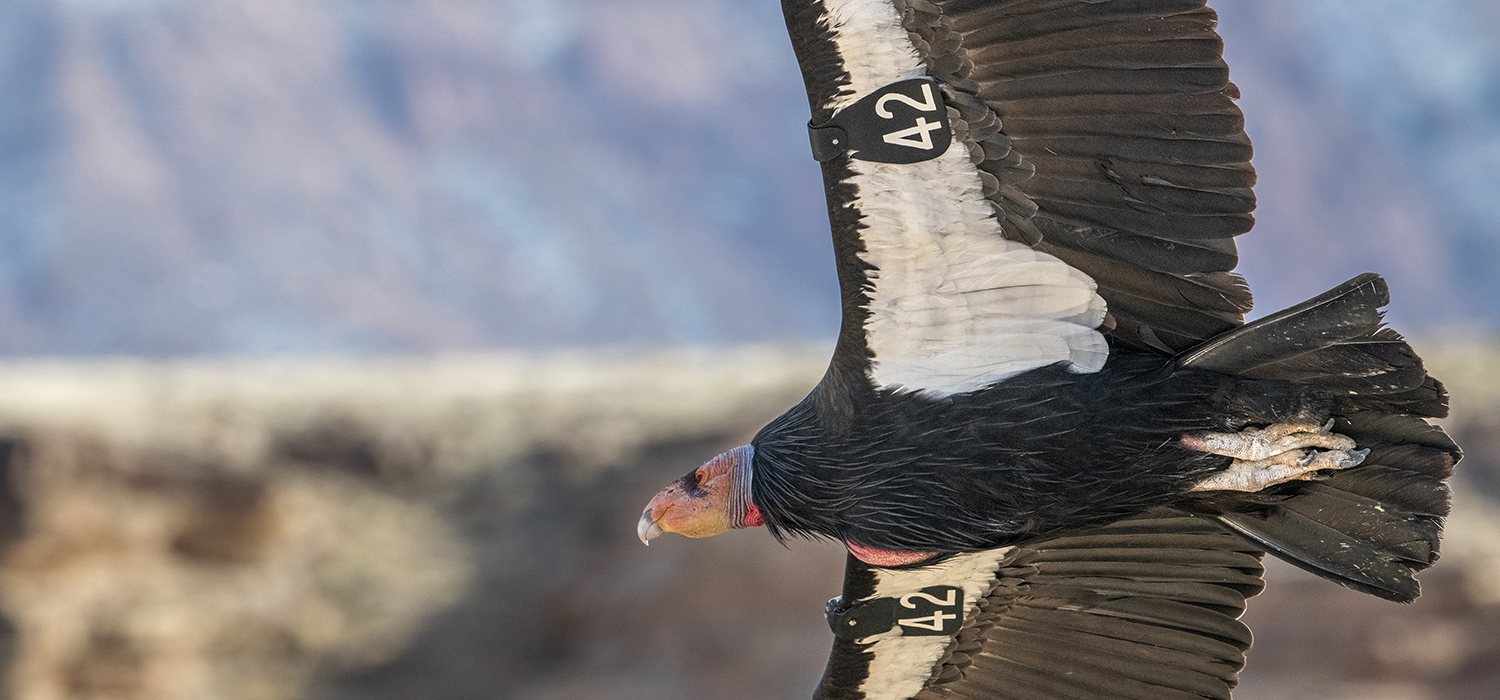
BY STEPHEN EGINOIRE
It's a luminous October morning in the Grand Canyon. And, ironically for us, it’s a beautiful day to be outside. We’ve just rappelled 250 feet from the rim of the Redwall Limestone to reach an exposed alcove partway down the cliff’s face. This inconspicuous feature, hidden among a sea of vertical rock, is, in fact, not an alcove, but an entrance to a vast and complex cave system, older than the Grand Canyon and unlike anywhere else known to exist on Earth.
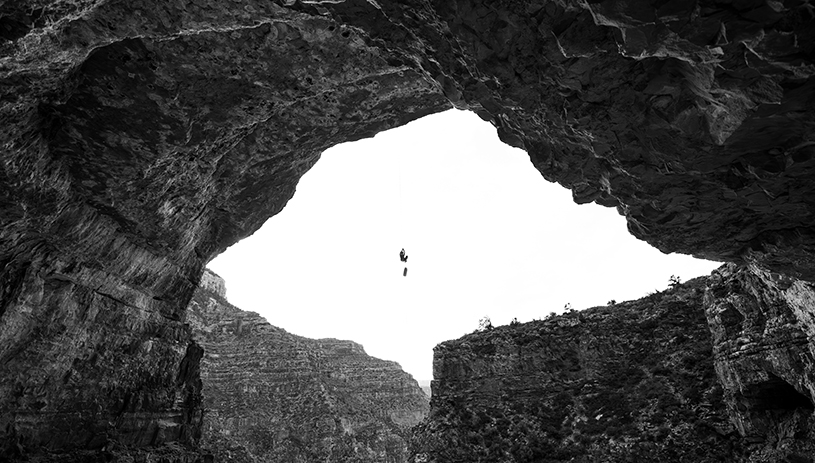
A fixed rope allows researchers to access the cave — a dramatic daily commute to and from base camp. STEPHEN EGINOIRE
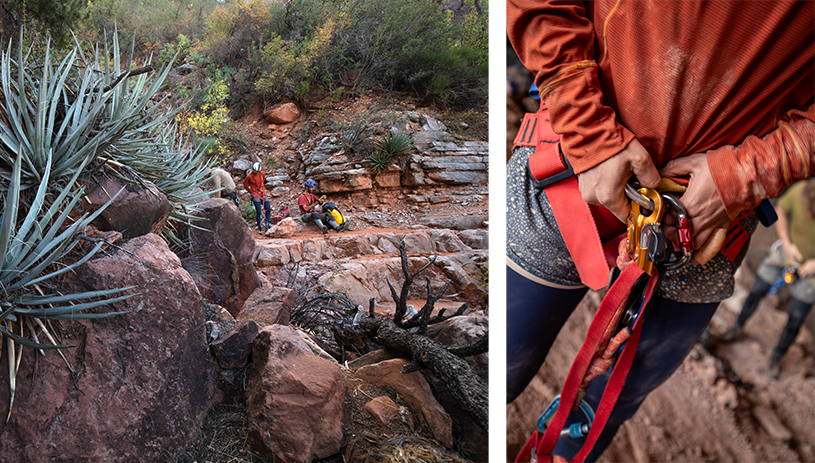 Miriam Schaffer and Ben Phillips gear up for a day underground. STEPHEN EGINOIRE
Miriam Schaffer and Ben Phillips gear up for a day underground. STEPHEN EGINOIRE
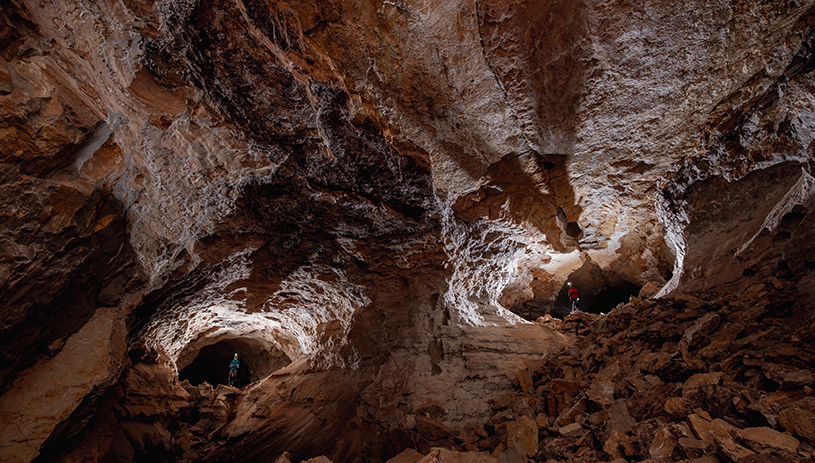 One of countless junctions in a dizzying maze of passages. STEPHEN EGINOIRE
One of countless junctions in a dizzying maze of passages. STEPHEN EGINOIRE 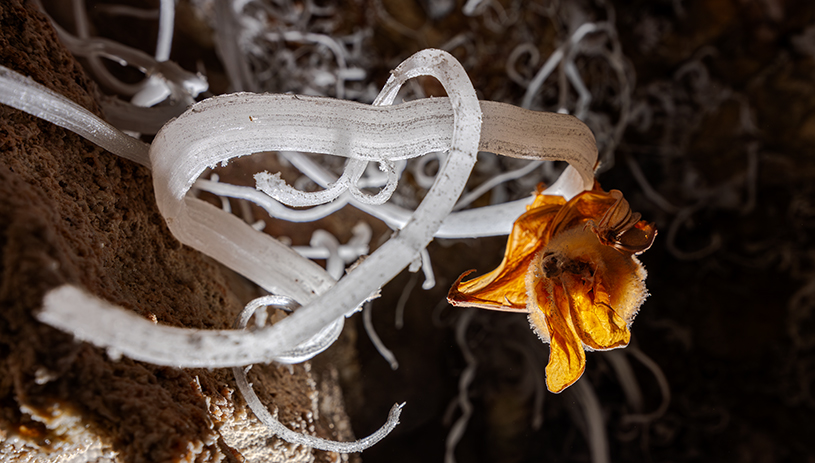
It was in 2010 when Carol Chambers, professor of wildlife ecology at Northern Arizona University, first caught wind of a surprising find made during an ongoing cave inventory project in a remote part of the Grand Canyon — a huge cave filled with lots of dead animals, mainly bats.
"I don’t know of anything else like it in the world. It just blows me away," Chambers said. "There have been other bats radiocarbon dated that are quite old, but there’s nothing preserved like these individuals. Elsewhere, remains are mostly skeletonized, and nothing like what you see in this cave. It’s truly astonishing."
The cave contains hundreds to possibly thousands of undisturbed individual bats, all of which are in their original places. Their age range and the sample size are simply unheard of, and the research opportunities are just now unfolding. While Townsend’s big-eared bat is the dominant species, at least 11 other species of preserved bats have been found in the cave system.
"I’m interested in ancient DNA work," Chambers said. "How have these species changed across time? Because we have such a large sample size, are we looking at the same kinds of genetics in these animals [today] as they were 50,000 years ago?"
Questions like this highlight the important role that caves play as habitat for wildlife and environments for preservation.
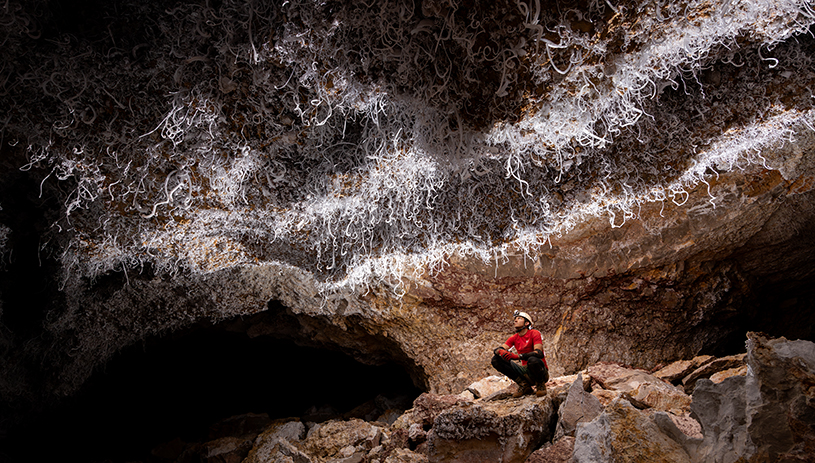 Andrew Chandler takes a break from mapping beneath a ceiling decorated with gypsum flowers. STEPHEN EGINOIRE
Andrew Chandler takes a break from mapping beneath a ceiling decorated with gypsum flowers. STEPHEN EGINOIRE
Over the past 20 years or so, Jason Ballensky, who founded the Grand Canyon Cave Research Project, has located, mapped, and inventoried more caves than any other individual in the modern recorded history of the Grand Canyon, revealing countless wonders in the process. The most significant, of course, being the aforementioned "bat cave," which now ranks as one of the world’s longest known caves.
This documentation has opened doors for people like Shawn Thomas and Carol Chambers to make their own findings that contribute to a deeper understanding of the Grand Canyon and its natural history. Recently, I caught up with Vince Santucci, senior paleontologist with the U.S. National Park Service, to chat about the exciting news.
Reiterating the significance of caves in the Grand Canyon and the rare opportunities they provide researchers, he said:
"There are portions of the fossil record that are preserved within this cave that may not be preserved in any other environmental setting in the Grand Canyon, or anywhere else in the world. We tend to have the hard parts, the bones, the shells, things like that. We’re finding that there has been this rare preservation of soft tissue. What is encountered in this particular cave is an anomaly. The value of being able to look at soft tissue preservation enables us to look at morphological characteristics: coloration of hair, size of ears, things that aren’t necessarily revealed when you look at bone. And then of course, the Carol Chambers component enables us this extremely rare opportunity to potentially look at ancient DNA."
Impassioned, Santucci continued:
The remarkably stable conditions found throughout the entirety of the cave account for the animals’ remarkable state of preservation. Inside the cave, it is cool, arid, and well-ventilated with multiple entrances, and, of course, absolutely dark. The alignment of elements that enable this unique harmony to exist is truly special.
First, a big cave is needed to provide a stable environment. Then, a spread of more enigmatic factors must align to yield an internal temperature and relative humidity that can remain unchanged for at least 50,000 years. This calibration is distinct. Fifty thousand years is only a minimum age, a value established at the outer limits of radiocarbon dating. It’s possible that the environment inside the cave, including many of the deceased animals, has been in a state of preservation for far longer.
Amazingly, the cave continues to provide important habitat to bats to this day; the mammals have been seen flying in and out of the cave where their ancestors have roosted for tens of thousands of years. So how old is this cave, exactly? The current answer, like much of the canyon’s geology, is: It’s a complicated mystery.
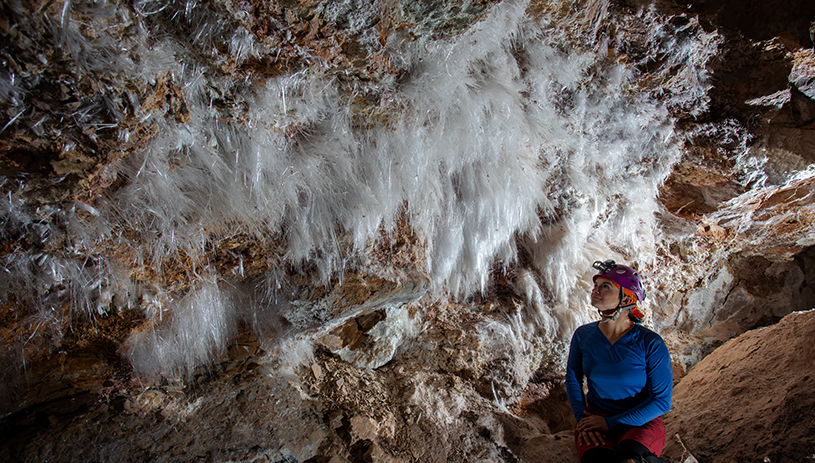 Beth Cortright contemplates a distinct display of dense gypsum needles and hairs. STEPHEN EGINOIRE
Beth Cortright contemplates a distinct display of dense gypsum needles and hairs. STEPHEN EGINOIRE
What is known about the cave’s origin and development — what scientists call its "speleogenesis" — extends into the realm of deep time, well before the Colorado River and its tributaries began carving through layers of rock to form the Grand Canyon we know today.
What exists today as a cave was once part of an ancient aquifer that formed deep below an ancient water table. The aquifer, contained entirely inside the Redwall Limestone, was dissolving, saturated with acidic water until it was crosscut by developing Grand Canyon tributaries. The system, essentially an intricate water tank, was sliced open by aggressive erosional forces occurring on the surface, causing fluids inside the cave to drain away completely.
Dating calcite formations in the cave’s former pool basins has provided researchers with enough data to establish a four million year timeline during which aridification took charge. It was during this extensive dry-out period that another anomaly occurred: profuse sulfate deposition. As moisture left the system, mineral deposits left behind as water evaporated — mainly gypsum — began forming crystals, crusts, needles, and other rare structures.
Today, breathtaking examples of these crystalline minerals are on display throughout much of the cave. Among them are gypsum flowers, a seldom-encountered formation extruding from the porous walls and ceilings of the cave like ribbons of glass. They occur in such dazzling numbers that those studying the cave are often left in a state of speechless disbelief. These anomalies — the crystals, the perfectly preserved animals, the vastness of the cave, and the stable environment within — are exceedingly rare, only made possible through the harmonious alignment of so many nuanced factors.
Shawn Thomas, who has been a key investigator since the surveying of this remarkable cave began in 2008, said, "My takeaway is that it highlights the importance of caves as habitats and as habitat anchors. This cave, and possibly others like it, is providing long-term habitat through climate change, not just for bats, but other wildlife as well. They might be some of the most stable environments to help support species through those changes."
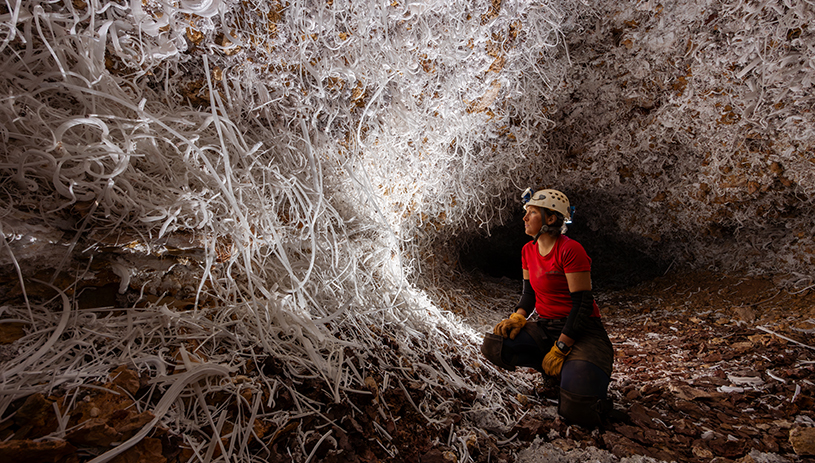 Irina Tabarana in an otherworldly place. STEPHEN EGINOIRE
Irina Tabarana in an otherworldly place. STEPHEN EGINOIRE
It begs the question: What other kinds of places are yet to be realized in the Grand Canyon, and what can we learn from them?
This cave is only one of an unknown number, and efforts to understand the mysteries found within have only just begun. Caves undoubtedly play an integral role within the Grand Canyon landscape, and there are a huge variety of them. Many caves in the park are conduits for freshwater springs that nurture plants and animals and provide clean drinking water to Indigenous communities and park visitors. While these kinds of places are protected directly within the national park, the risk of pollution from uranium mining, among other activities taking place outside the park, requires direct action from all of us to ensure a healthy future for the Grand Canyon.
An outstanding example of this forward-thinking mentality was clearly demonstrated by the recently designated Baaj Nwaavjo I’tah Kukveni national monument. The monument ensures that 917,618 acres of forests and grasslands to the north and south of Grand Canyon National Park, including cultural and religious areas, plants, animals, and important water sources flowing into the Colorado River, are stewarded responsibly, including caves.
In the words of Vince Santucci, "We…have only just begun to scratch the surface. Most of what is to be learned about the history of life on planet Earth is yet to be realized. It’s still out there, buried in caves and in badlands…how we manage and how we protect these resources in the Grand Canyon…is of the utmost importance."
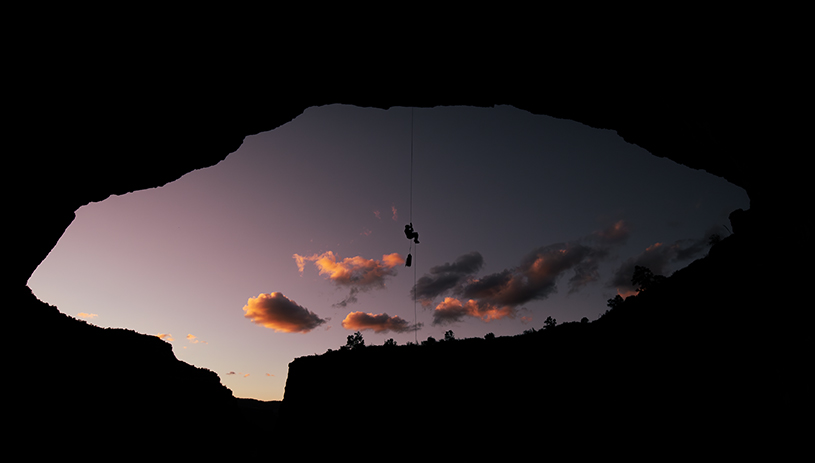
When Shawn, Jason, and I exit the cave, it is already dark outside. The sun, long gone beyond the western horizon, still casts a pale cerulean hue into the night sky. A gentle up-canyon breeze carries the scent of ozone and minty vegetation after an apparent fresh rain. We are surrounded by an atmosphere that feels particularly vibrant and dynamic, moving at light speed compared to the timeless realm inside the cave.
One by one, we ascend our rope leading back to familiar sights, sounds, smells, faces, and eventually cozy sleeping bags. Giant cliffs, as tall as ever, frame the heavens with precise, geometric lines. Orion beams overhead. Walking along the rim, I can’t help but feel like an interdimensional traveler, passing from one world and into another.
Stephen Eginoire is a photojournalist, writer, and designer based in southwest Colorado. Find more of his work at stepheneginoire.com.
EDITOR'S NOTE: The views expressed by Advocate contributors are solely their own and do not necessarily represent the views of the Grand Canyon Trust.
